


Summary. 21 cm observations are reported for the galaxy NGC 2841. Maps with angular resolution of 51" × 65" are presented. The 21 cm continuum radiation extends over the bright optical disk (~ 6' in diameter). The HI distribution is surprisingly large: it extends to about 2.5 times the Holmberg diameter of 11.3'. Both the HI distribution and the radial velocity field indicate that NGC 2841 has a warped HI disk in the outer parts. NGC 2841 is probably a fairly isolated galaxy, therefore the origin and maintenance of the warp is puzzling. The mass-to-luminosity ratio, especially in the outer parts must be high, the dark material could be distributed in a halo. There is a "hole" in the HI distribution in the inner parts of this multi-armed galaxy.
The galaxy NGC 2841 has been classified as SA(r)b (De Vaucouleurs et al., 1976) but unlike the Sab galaxy M81 it does not display a well defined two-armed spiral structure. Instead, a tightly wound multiple arm pattern can be seen, made up of small bits of luminous matter intermixed with dust patches (see Fig. la). The central regions are dominated by an amorphous nuclear bulge. The angular size of the galaxy is 11.3' × 5.7' (Holmberg, 1958).
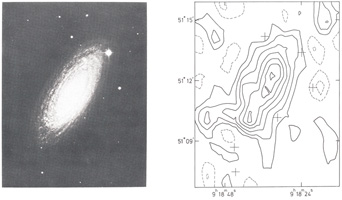 |
Figure 1. a photograph of NGC 2841 taken with the 200-inch telescope at Hale Observatories, b 21 cm continuum map of NGC 2841 at the same scale as the photograph. The contour interval is .29 K, dashed contours are negative and the zero contour is omitted. |
Little is known about this galaxy, despite the fact that Hubble (1936) regarded it as a prototype Sb-galaxy in his original classification. Van Houten, Oort and Hiltner (1954) obtained photoelectric scans along the major and minor axis. Artamonov et al. (1966) presented photographic photometry of the inner parts. Roberts (1968) measured the HI profile.
We have observed this galaxy in the 21 cm HI line, with the Westerbork Synthesis Radio Telescope (WSRT), as part of a program to study the distribution and kinematics of the neutral hydrogen in spiral galaxies of various morphological types (Bosma, 1978). The angular resolution (51" × 65") is sufficient to study the larger scale kinematics of this galaxy. It was thought that a galaxy as symmetric and nearly featureless as NGC 2841 should be a good example of a spiral galaxy with axial symmetry. Our results, however, indicate that this is not the case. The HI extends to about 30' diameter, which is 2.5 times the Holmberg diameter. The outer HI layers seem to lie in a plane different from the one defined by the bright optical disk. We will describe the observations and data processing in section 2 of this paper; the results will be presented in section 3 and discussed in section 4.
2. Observations and data processing
The observations have been made with the WSRT and its 80 channel
filterspectrometer
(Allen et al., 1974).
Data have been recorded at
ten antenna spacings, ranging from 36 m to 684 m in steps of 72 m.
To cover the radial velocity range of the galaxy five settings of the
local oscillator were necessary, which provided 40 velocity channels
centred at heliocentric velocities 200, 240, 280, 320, 340, .......,
940, 960, 1000, 1040, 1080, and 1120 km s-1. The filterwidth
of each channel is 129 kHz, corresponding to a velocity resolution of
27.2 km s-1. Maps have been produced by application of the
standard WSRT procedure for calibration and Fourier transformation
(Högbom and Brouw,
1974).
The synthesized beamwidth is
51" × 65"( ×
×
 ) at half
power; grating responses have dimensions of 10' × 13'. The rms noise
in one channel is 0.7 K.
) at half
power; grating responses have dimensions of 10' × 13'. The rms noise
in one channel is 0.7 K.
The channel maps contain both line and continuum radiation. The number of channels completely free of line emission is so small that subtraction of a map formed by averaging these channels causes a degradation of the rms noise level in the final line channel maps. As in the case of NGC 5033 (Bosma, 1978) we have therefore followed a different course of analysis. Since the background continuum sources in the maps all have a small amplitude their instrumental responses do not influence the emission of the galaxy. The emission of the galaxy itself, however, is influenced by instrumental responses. The galaxy turned out to be so large in HI that in some of the extreme radial velocity channels a positional overlap occurs of the source and its own grating response. Although in these cases the sampling theorem is violated, the effect is small and does not lead to a significant loss of information. Another problem is that because of the chosen interferometer configuration, the base level of the maps is not zero. We have applied the procedure CLEAN (Högbom, 1974) to cure all these effects. The resulting maps are free of the sidelobes and grating responses caused by the emission of the galaxy; the base level of the maps turned out to be zero now, indicating that no significant amount of HI is missing in our data. We have processed these maps further with the window method (Bosma, 1978) to derive a map of the continuum radiation of the galaxy, continuum free line channel maps, and maps of the HI distribution and the radial velocity field. We have checked whether we did indeed recover all the HI flux density in the maps by computing an integrated HI profile and comparing this profile with data from single dish telescopes. The agreement is within the error margins, but the quality of the single dish data is not very high.
We have processed the 21 cm continuum map further: all the background sources and their instrumental responses have been subtracted. The resulting map is shown in Fig. 1b. Noteworthy about this map is that its extent is about half the Holmberg size of the galaxy. In another paper (Hummel and Bosma, 1978) we will present a higher resolution 21 cm map, a map at 49 cm and the spectral index distribution between 21 and 49 cm.
In Fig. 2 we show the channel maps containing line radiation. From these maps we conclude we conclude that the outer parts of NGC 2841 do not follow the kinematical behaviour of the inner parts. The channels at extreme radial velocities were expected to show emission along a straight line with the same position angle as the major axis of the optical disk. This is clearly not the case, there is a bend beyond about 6' from the centre.
In Fig. 3 we present the map of the HI distribution superimposed on a print of a KPNO 4 m IIIaJ plate taken by Dr. H.C. Arp of the Hale Observatories, and kindly provided by him. The rms noise level in the map is variable due to the varying number of channels used in the summation; at most places it is about 7 × 1019 atoms cm-2.
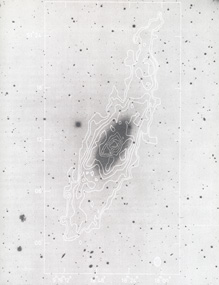 |
Figure 3. Map of the HI column density distribution of NGC 2841, superimposed on a print of a KPNO 4 m IIIaJ plate taken by Dr. H.C. Arp. The contours are 1.05, 2.1, 4.2, 6.3, 8.4, and 10.5 times 1020 atoms cm-2. |
We note the following points about this map:
The extent of the HI distribution is about 30', which is 2.5 times the Holmberg diameter.
There is a hole in HI in the central region of the galaxy. The size of this hole corresponds with the dimensions of the bright amorphous bulge in the starlight.
There is a ringlike distribution of HI with mean projected radius about 5'. The ring is not complete: breaks occur on both sides of the galaxy at a position angle close to that of the major axis.
The outer HI structure has an orientation in the sky that differs from that of the main body of the galaxy. Moreover, an asymmetry exists between the northern and the southern parts. No optical emission has been found coincident with this HI emission, not even on a superposition of two 1.2 m Schmidt IIIaJ plates (Van der Kruit, 1978). This means that the surface brightness of blue light has dropped below the level of 27.5m per square arcsec.
We have integrated the line channel maps to determine the
total HI mass of this galaxy. Assuming a distance of 9 Mpc, based
on the systemic velocity and a Hubble constant of 75 km s-1
Mpc-1, we find
MHI = 2.8 × 109
M . The
integral HI profile, corrected for
the primary beam of the telescopes, is shown in
Fig. 4. Note that
there is a difference in flux density between adjacent channels in
the velocity range between 420 and 540 km s-1. This is probably
related to the low signal to noise ratio, see the channel maps in
Fig. 2, and the fact that we had to reobserve
part of the data at
one setting of the local oscillator to correct for solar interference.
. The
integral HI profile, corrected for
the primary beam of the telescopes, is shown in
Fig. 4. Note that
there is a difference in flux density between adjacent channels in
the velocity range between 420 and 540 km s-1. This is probably
related to the low signal to noise ratio, see the channel maps in
Fig. 2, and the fact that we had to reobserve
part of the data at
one setting of the local oscillator to correct for solar interference.
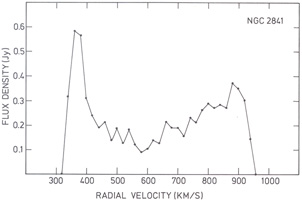 |
Figure 4. Integral HI profile of NGC 2841, as derived from the line channel maps. |
We have studied the individual line profiles to see whether there are any double-peaked profiles. Most profiles have a simple shape with one peak; in that case the intensity weighted mean radial velocity can be determined with an accuracy better than 10 km s-1. In Fig. 5 we present the map of the radial velocity field, again superimposed on the IIIaJ print. This map shows a high degree of symmetry between the northern and the southern parts. In the inner parts we find the pattern expected for a disk in differential rotation seen in the orientation indicated by the bright optical disk. In the outer parts, however, the kinematical major axis, i.e. the line of extreme radial velocities, has a different position angle. The change of position angle is similar to the one in the orientation of the contours of the HI distribution, suggesting a common explanation for both phenomena.
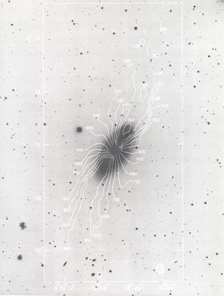 |
Figure 5. Map of the radial velocities in NGC 2841, superimposed on the IIIaJ print. The numbers indicate heliocentric velocities in km s-1. |
In some places in the galaxy, notably at radii where the major axis starts to change position angle, the line profiles are rather broad. This is illustrated in Fig. 6a and b where we show two sets of position-velocity plots along lines of constant declination. At the southeast and northwest positions the profiles are very broad. Indeed, as can be seen from the channel maps in Fig. 2, at these points many channels show detectable line emission. In Fig. 6c we show a position-velocity plot along the minor axis of the optical disk. Note that the kinematical minor axis is well aligned with the optical one. This is not so evident in the contour plot of Fig. 5, mainly because the rapid change in radial velocity over a very small number of independent beam areas makes it difficult to trace the contours accurately.
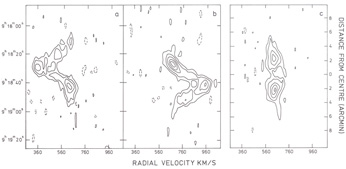 |
Figure 6. Position velocity diagrams:
a along a line at
|
The general properties of the HI distribution and the radial
velocity field in NGC 2841 are similar to those found in NGC 5055
(Bosma, 1978).
We attribute the deviations from axial symmetry in
the outer parts to a warping of the plane of the gas layer. As for
NGC 5055 we have tried to construct a descriptive
warp model by
dividing the galaxy into concentric annuli, allowing each annulus
to have its own orientation in the sky. For the position of the
rotation centre we took the position of the continuum source given
by Hummel and Bosma
(1978):
 =
9h18m36.2s,
=
9h18m36.2s,
 = 51°11'26",
(1950.0).
= 51°11'26",
(1950.0).
From the symmetry in the inner parts we derive a systemic velocity of
635 ± 5kms-1. In each annulus we have calculated,
for a given set of position angles of the major axis of the ring,
 , and
inclinations, i, the mean circular velocity,
Vc, and the dispersion of
the velocities around this mean. The final values for
, and
inclinations, i, the mean circular velocity,
Vc, and the dispersion of
the velocities around this mean. The final values for
 and i are
chosen such that the dispersion around the mean Vc is
a minimum. For NGC 5055 a satisfactory fit was possible. In the
case of NGC 2841, however, we encountered a difficulty: if
we take the results
at face value and calculate a model velocity field and HI distribution,
we find that the model galaxy is less inclined to the line of
sight than indicated by the observed HI distribution. This problem
is related to the broad profiles we found (see
Fig. 6). If we increase
the inclination of the outer annuli in such a way that at the
positions where the broad profiles occur various annuli overlap
within the beam, then we get a much better resemblance of the model
velocity field with the observed one. This implies that the dispersion
in the mean Vc is not a minimum: this method is not
satisfactory at high inclinations. In Fig. 7a-d
we show the best fitting results for the radial variation of
and i are
chosen such that the dispersion around the mean Vc is
a minimum. For NGC 5055 a satisfactory fit was possible. In the
case of NGC 2841, however, we encountered a difficulty: if
we take the results
at face value and calculate a model velocity field and HI distribution,
we find that the model galaxy is less inclined to the line of
sight than indicated by the observed HI distribution. This problem
is related to the broad profiles we found (see
Fig. 6). If we increase
the inclination of the outer annuli in such a way that at the
positions where the broad profiles occur various annuli overlap
within the beam, then we get a much better resemblance of the model
velocity field with the observed one. This implies that the dispersion
in the mean Vc is not a minimum: this method is not
satisfactory at high inclinations. In Fig. 7a-d
we show the best fitting results for the radial variation of
 , i,
Vc,
and the projected surface density of neutral hydrogen,
, i,
Vc,
and the projected surface density of neutral hydrogen,
 H(r). The
corresponding model HI
distribution and velocity field are presented in
Fig. 8, while in
Fig. 9 we show the resulting position velocity
plots at the same
positions as those in Fig. 6. The agreement with
the observations is
good; we can, of course, not explain the asymmetries in the HI
distribution described in section 3 b(4) with this
model.
H(r). The
corresponding model HI
distribution and velocity field are presented in
Fig. 8, while in
Fig. 9 we show the resulting position velocity
plots at the same
positions as those in Fig. 6. The agreement with
the observations is
good; we can, of course, not explain the asymmetries in the HI
distribution described in section 3 b(4) with this
model.
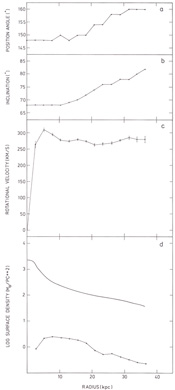 |
Figure 7. Radial distributions of the position angle of the major axis a, inclination b, rotation velocity c and surface densities of total mass and HI gas mass d (upper and lower respectively). |
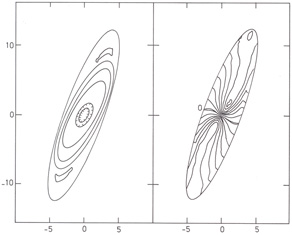 |
Figure 8. The HI contour shapes (left) and radial velocity field (right) resulting for the tilted ring model described in the text. The contour unit of the velocity map is 40 km s-1, the contour labeled zero corresponds to 635 km s-1, the other contours have the same label as in Fig. 5. |
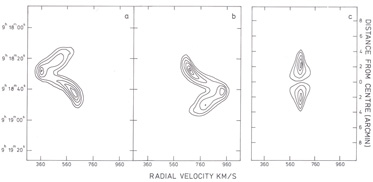 |
Figure 9. Position velocity diagrams resulting from the tilted ring model along the same lines, and with the same contour intervals, as in Fig. 6. |
As in the case of NGC 5055 we do not know whether the curve of
Vc(r) in Fig. 7c really
is the rotation curve of the galaxy, but we
make the assumption that it is. No correction can be made for the
possible effects of beamsmoothing in the central regions since no
optical velocities are available. We have computed a mass model with
the thin disk method outlined by
Nordsieck (1973).
The curve of the
cumulative mass within a given radius is almost a straight line,
indicating that M(r) - r. The mass out to 36 kpc,
Mo, is 5.0 × 1011
M .
From BTo = 9.58
(De Vaucouleurs et al.,
1976)
we find a total blue luminosity of 1.77 × 1018
L
.
From BTo = 9.58
(De Vaucouleurs et al.,
1976)
we find a total blue luminosity of 1.77 × 1018
L . Hence
Mo / L
. Hence
Mo / L
 28. Since there is no
indication that the rotation curve becomes
Keplerian beyond 36 kpc radius
the actual M / L may be larger. Indeed, a fit to the
rotation curve with the fitting method described by
Shu et al. (1971),
which uses a number of spheroids and a disk, yields a total mass,
Mt, of 1.25 × 1011
M
28. Since there is no
indication that the rotation curve becomes
Keplerian beyond 36 kpc radius
the actual M / L may be larger. Indeed, a fit to the
rotation curve with the fitting method described by
Shu et al. (1971),
which uses a number of spheroids and a disk, yields a total mass,
Mt, of 1.25 × 1011
M , hence
Mt / L
, hence
Mt / L
 71. In the inner
parts we can compare the curve of
the mass surface density distribution (Fig. 7)
with a radial luminosity
profile derived from the photometry by
Artamonov et al. (1966).
Although our mass model in the inner parts (r < 3') is probably
inadequate we find there the conventional value
M / L
71. In the inner
parts we can compare the curve of
the mass surface density distribution (Fig. 7)
with a radial luminosity
profile derived from the photometry by
Artamonov et al. (1966).
Although our mass model in the inner parts (r < 3') is probably
inadequate we find there the conventional value
M / L  15 ± 7 (it is
not clear to which wavelength region the photometry refers to, we
have assumed it to be in the blue). Clearly the trend is that M /
L increases with radius; in the outer parts it may reach a value
of 100 or more.
15 ± 7 (it is
not clear to which wavelength region the photometry refers to, we
have assumed it to be in the blue). Clearly the trend is that M /
L increases with radius; in the outer parts it may reach a value
of 100 or more.
Although we have used thin disk models, the actual distribution
of matter may be quite different. It could very well be that
NGC 2841 is surrounded by a dark spherical halo,
which stabilizes the disk (cf.
Ostriker and Peebles,
1973).
By way of exercise we have
calculated the following crude model: We ignore the nuclear bulge
for the moment and assume an exponential disk with the same scale-length
as the one of the light distribution:
 -1 = 4.65
kpc. This results in a turnover radius of 10 kpc. For the halo we assume a
volume density law
-1 = 4.65
kpc. This results in a turnover radius of 10 kpc. For the halo we assume a
volume density law
 (r) =
(r) =
 o
b2(r2 +
b2)-1. Then
V2 halo
= 4
o
b2(r2 +
b2)-1. Then
V2 halo
= 4 G
G
 o
b2(1 - b/r arctan b)
(Bergeron and Gunn,
1976).
A good fit is obtained for b = 8.8 kpc; we then have
Mdisk = 1.8 × 1011
M
o
b2(1 - b/r arctan b)
(Bergeron and Gunn,
1976).
A good fit is obtained for b = 8.8 kpc; we then have
Mdisk = 1.8 × 1011
M , and
Mhalo(r = 40
kpc) = 5.0 × 1011
M
, and
Mhalo(r = 40
kpc) = 5.0 × 1011
M . An
equally good fit is obtained if we take a Toomre nT =
1 disk
(Toomre, 1963)
instead of an exponential disk, but then b = 11 kpc,
Mdisk = 2.8 × 1011
M
. An
equally good fit is obtained if we take a Toomre nT =
1 disk
(Toomre, 1963)
instead of an exponential disk, but then b = 11 kpc,
Mdisk = 2.8 × 1011
M ,
and Mhalo(r = 40 kpc) = 4.6 ×
1011M
,
and Mhalo(r = 40 kpc) = 4.6 ×
1011M
 . Therefore
Mhalo(r = 40 kpc) / Mdisk
varies between 1.6
and 2.8, depending on the assumed disk model. This illustrates the
ambiguity which occurs if a three-dimensional mass model has to be
constructed from a one-dimensional rotation law.
. Therefore
Mhalo(r = 40 kpc) / Mdisk
varies between 1.6
and 2.8, depending on the assumed disk model. This illustrates the
ambiguity which occurs if a three-dimensional mass model has to be
constructed from a one-dimensional rotation law.
Although we can describe the observed HI column density distribution and the radial velocity field quite easily in terms of a warped HI layer, the origin and maintenance of this warp is not so obvious. As for the warp in NGC 5055 (see paper I for a more complete discussion) there are various possibilities. In Table 1 we have collected some properties of galaxies in the neighbourhood of NGC 2841. The selection of the galaxies is based on group assignments made by De Vaucouleurs (1975). None of the galaxies in Table 1 is close enough to NGC 2841 to have caused the warp less than 2 × 109 years ago by way of tidal interaction. Moreover, also no dwarf galaxy has been detected in HI which lies within 30 projected distance of NGC 2841 (Fisher and Tully, priv. comm.). Hence we can add NGC 2841 to the list of warped galaxies with no nearby companions.
| Galaxy | Type | BTo | LB(109
L ) ) |
V (km s-1, heliocentric) | Distance
 D from
NGC 2841 (') D from
NGC 2841 (') |
| NGC 2500 | SB(rs)d | 11.85 | 2.2 | 499 ± 30 | 760 |
| NGC 2537 | IB(S)m pec. | 12.01 | 1.9 | 411 ± 18 | 754 |
| NGC 2541 | SA(S)cd | 11.73 | 2.4 | 564 ± 8 | 647 |
| NGC 2552 | SA(S)m | 12.36 | 1.4 | 511 ± 17 | 597 |
| NGC 2681 | PSAB(rs)o/a | 10.79 | 5.8 | 710 ± 27 | 271 |
| NGC 2841 | SA(r)b | 9.58 | 17.7 | 635 ± 5 | - |
† All entries, except
LB, V(N 2841) and
 D, from
De Vaucouleurs et
al. (1976) D, from
De Vaucouleurs et
al. (1976) |
|||||
If we accept that NGC 2841 is surrounded by a dark spherical halo being at least twice as massive as-the disk then the arguments given in paper I for the increase in the time before the warp washes out may hold. In that,case the warp may disappear in 5 × 109 years or so. It could then have originated during the passage of one of the galaxies listed in Table 1, e.g. NGC 2681, at 710 kpc projected distance. Note, however, that if the warp in NGC 2841 has been pulled by a companion of similar size and at present at a relative distance similar to that of M31 and our Galaxy, we might expect every large galaxy to be warped. This is, however, not generally the case, for instance NGC 891, an outlying member of the NGC 1023 group, is not warped (Sancisi, 1976). Of course, the presence of a halo can only solve the warp problem satisfactory if it can be shown that long lived modes of warping can exist (cf. Toomre, 1977).
Recently, Binney (1978) has worked out some consequences of the assumption that the gravitational fields of spiral galaxies are dominated by the contribution of a dynamically hot component which has characteristics similar to those inferred for elliptical galaxies. He shows that if one accepts that this hot component has a triaxial shape then there should be a misalignment between the apparent minor axis of the disk and the HI zero-velocity contour, because in the plane of the disk the flow will be in first order along similar concentric ellipses. Moreover, the disk itself is liable to an integral sign warp. Since we have argued above that a dark halo around NGC 2841 cannot be excluded this galaxy might show some of the predicted effects. The successful fit of the ring tilt model to the observations suggests that NGC 2841 is indeed warped, but this model, by its nature, does not have a misalignment of the apparent minor axis and the HI zero-velocity contour in the inner parts. Furthermore, the orientation parameters of the inner annuli agree very well with those derived optically from the outer (23.5m) isophotes given by Artamonov et al. (1966). This suggests that in the inner parts the flow is circular, or at least the deviations from axial symmetry are not noticeable. Hence if an aspherical hot stellar component is present in NGC 2841, it does not dominate the gravitational field in the inner parts to the extent that the gas flows along elliptical orbits there. In the outer parts the situation may be different: it is not possible to distinguish observationally between elliptical orbits in the plane of the optical disk and circular orbits in a different plane.
The rotation curve in Fig. 7c can also be used for the construction of a density wave model, as an addition to the 24 galaxies discussed by Roberts et al. (1975). We find that NGC 2841 should belong to the class of galaxies where strong two-armed spiral shocks can occur. The absence of these shocks indicates that the mechanism to produce them is absent in NGC 2841. It is very suggestive that in the well known cases where shocks are thought to be present (M31, M51, M81, M101) a forcing mechanism for a density wave can be found in terms of the presence of one or more companions (cf. Toomre and Toomre, 1972). We cannot claim, however, that a two-armed spiral structure is always induced by the presence of a companion. NGC 3198 is an example of a fairly well isolated galaxy with a two-armed spiral structure (see Bosma, 1978). But in this case a central bar is present which could have excited a density wave. On none of the published photographs of NGC 2841 a hint of a barlike structure can be found. Perhaps the absence of a bar or the relative isolation from other galaxies prevented the development of a clearcut spiral structure in this galaxy.
The absence of HI in the central regions of NGC 2841 poses an
interesting problem. Only in other galaxies with large bulges: M31
and M81 such a hole in the HI has been observed. In many
other galaxies the surface density of HI decreases towards the centre,
but it does not drop below
1.0 M pc-2. Note that in some cases the
large beamsizes can influence this conclusion.
Oort (1974)
suggests
that central depressions in the radial distribution of the gas in
spirals can occur by formation of stars during the passage of a
spiral wave. In the central parts the gas rotates faster and more
gas is converted into stars.
Segalovitz (1975)
has worked out this idea for the galaxy M81 and concludes that a good fit to the
observations is obtained if the initial disk-like gas distribution is
proportional to the inverse square of the radius. NGC 2841 has a radial
distribution of HI gas (at least in the optically visible disk), similar
to M81, but no two-armed spiral structure. Hence it is
difficult to envisage that the central hole in NGC 2841 can arise from a star
formation process which is related to the passage of a quasi-stationary
spiral wave.
pc-2. Note that in some cases the
large beamsizes can influence this conclusion.
Oort (1974)
suggests
that central depressions in the radial distribution of the gas in
spirals can occur by formation of stars during the passage of a
spiral wave. In the central parts the gas rotates faster and more
gas is converted into stars.
Segalovitz (1975)
has worked out this idea for the galaxy M81 and concludes that a good fit to the
observations is obtained if the initial disk-like gas distribution is
proportional to the inverse square of the radius. NGC 2841 has a radial
distribution of HI gas (at least in the optically visible disk), similar
to M81, but no two-armed spiral structure. Hence it is
difficult to envisage that the central hole in NGC 2841 can arise from a star
formation process which is related to the passage of a quasi-stationary
spiral wave.
It seems more likely that the hole in HI in galaxies with large bulges is directly related with the formation of the bulge in the early history of a galaxy. Nuclear bulges in spiral galaxies are in some aspects analogous to ellipticals: the stellar populations are similar. Hence, as for E galaxies, the question can be raised why mass loss of the evolving stars did not fill up the hole. Perhaps the same mechanism which keeps ellipticals clean of gas operates also in the nuclear bulges of early type spirals like NGC 2841 (see Faber and Gallagher, 1976). Since NGC 2841 is a fairly isolated galaxy this mechanism is probably intrinsic to the galaxy.
From our 21 cm line observations of NGC 2841 we conclude:
The extent of the HI distribution is 2.5 times the Holmberg size.
The HI in the outer regions does not lie in the same plane as the optical disk.
Since NGC 2841 does not have, nearby companions this warp cannot arise from a recent tidal interaction.
NGC 2841 is very massive: the rotation curve remains more or less flat at a level of 280 km s-1 out to 36 kpc.
The mass-to-light ratio increases as function of radius; in the outer parts it could be 100 or more. The mass could reside in a halo.
The warp can be described fairly successfully with a tilted ring model, thereby constraining the asphericity of a possible massive halo.
We have collected a few parameters of NGC 2841 in Table 2.
| Position (1950.0) |  =
9h18m36.2s, =
9h18m36.2s,
 = 51°11'26" = 51°11'26" |
| Size (Holmberg, 1958) | 11'.3 × 5.7' |
| Adopted distance | 9 Mpc |
| Luminosity | 1.77 × 1010
L |
| HI mass | 2.8 × 109
M |
Total mass,
M , out
to 36 kpc , out
to 36 kpc |
5.0 × 1011
M |
| MHI / Mo | 0.0056 |
| MHI / LB | 0.16 |
| Mo / LB | 28 |